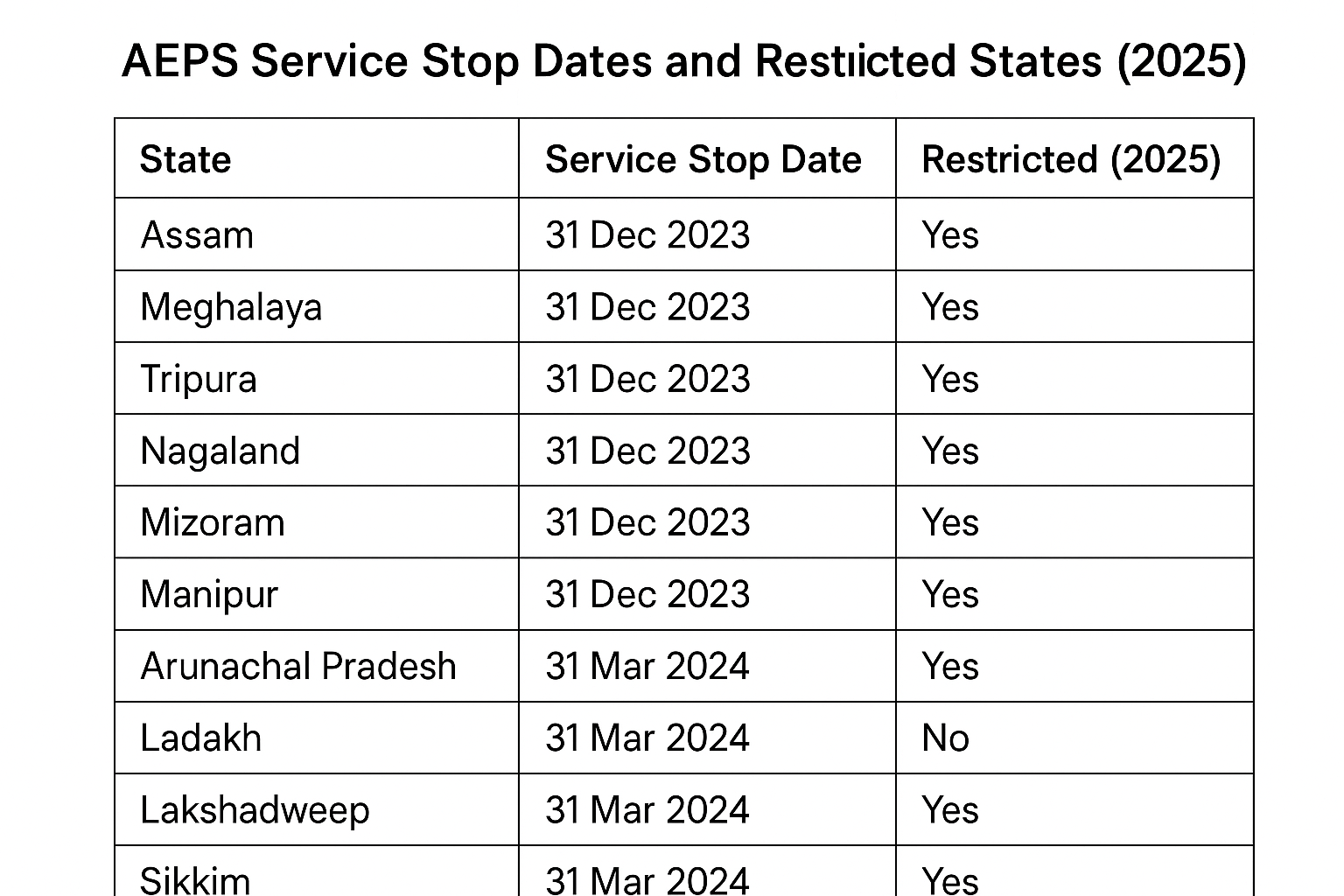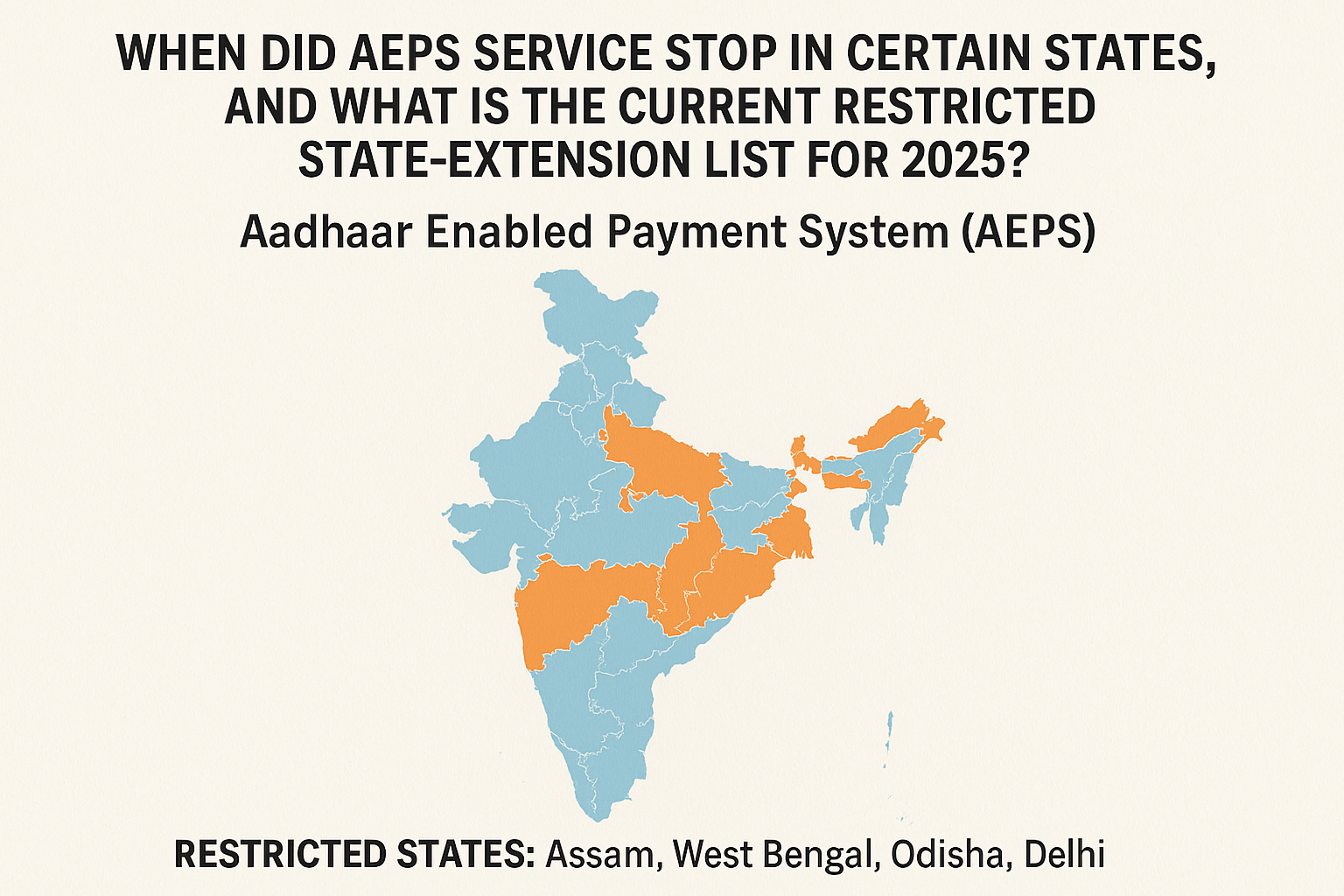The Aadhaar Enabled Payment System (AEPS) has been a game-changer for financial inclusion in (AEPS Service Stop) India, allowing millions to access banking services using just their Aadhaar number and biometrics. However, recent updates have left many wondering: When did AEPS service stop in certain states, and what is the current restricted state-extension list for 2025?
In this article, we’ll explore the latest developments, why some states have restricted AEPS services, and what it means for users. We’ll also provide a detailed restricted state-extension list for 2025 to help you stay informed.
What Is AEPS and Why Is It Important?
Before diving into the restrictions, let’s quickly recap what AEPS is. Launched by the National Payments Corporation of India (NPCI), AEPS allows users to perform basic banking transactions—like deposits, withdrawals, and balance checks—using only their Aadhaar number and fingerprint authentication.
This system has been crucial for:
-
Rural populations with limited access to traditional banking.
-
Government subsidy transfers (e.g., DBT, pensions).
-
Micro-ATM transactions through banking correspondents.
However, due to security concerns and regulatory changes, AEPS services have been temporarily or permanently restricted in some states.
When Did AEPS Service Stop in Certain States?
The AEPS service has not been completely stopped nationwide, but restrictions have been imposed in specific regions due to:
-
Fraudulent Activities – Rising cases of biometric fraud and unauthorized transactions.
-
Regulatory Compliance – State governments enforcing stricter KYC norms.
-
Technical Upgrades – Some banks and states are transitioning to more secure AEPS 2.0.
Key Dates of AEPS Restrictions
-
2023: Initial restrictions in Jammu & Kashmir and Northeastern states due to security concerns.
-
Mid-2024: Temporary suspension in Punjab, Haryana, and Rajasthan following a surge in fraud cases.
-
Early 2025: New restrictions in Uttar Pradesh, Bihar, and Jharkhand to curb illegal transactions.
Current Restricted State-Extension List of 2025
As of March 2025, the following states have partial or full restrictions on AEPS services:
| State | Restriction Type | Expected Resolution |
|---|---|---|
| Jammu & Kashmir | Full suspension | Under review |
| Assam | Limited to government schemes only | Q2 2025 |
| Punjab | Biometric transactions blocked | Q3 2025 |
| Rajasthan | Daily transaction cap (₹5,000) | Permanent |
| Uttar Pradesh | Rural areas only | Under review |
| Bihar | Temporary halt for upgrades | Q2 2025 |
| Jharkhand | Limited to select banks | Q4 2025 |
Note: Restrictions may change based on government and NPCI notifications. Always check with your bank for the latest updates.

Why Are These Restrictions Happening?
1. Rising Fraud Cases
-
Biometric spoofing (fake fingerprints) has led to unauthorized withdrawals.
-
Micro-ATM scams where agents misuse customer data.
2. Stricter RBI & NPCI Guidelines
-
Mandatory two-factor authentication (biometric + OTP) in high-risk zones.
-
Transaction limits to prevent large-scale fraud.
3. State-Specific Security Concerns
-
J&K and Northeast: Security risks due to regional challenges.
-
UP & Bihar: High volume of fraudulent transactions in rural banking.
What Does This Mean for AEPS Users?
If you live in a restricted state, you may experience:
✔ Limited transaction amounts (e.g., ₹5,000 per day in Rajasthan).
✔ Delays in subsidy transfers due to verification processes.
✔ Need for alternative banking methods (UPI, ATMs, or bank visits).
Pro Tip: If AEPS is unavailable, use UPI or USSD-based banking (*99#) for basic transactions.
Will AEPS Be Fully Restored in 2025?
While some states may lift restrictions after security upgrades, others (like J&K) may keep them longer. The NPCI is working on AEPS 2.0, which will include:
-
Enhanced biometric security (iris scanning in addition to fingerprints).
-
Real-time fraud detection using AI.
-
Stricter agent onboarding to prevent misuse.
Expected Rollout: Late 2025 (initially in non-restricted states).

Frequently Asked Questions (FAQs)
1. Is AEPS completely banned in India?
No, AEPS is still operational in most states, but some have imposed restrictions.
2. Can I still use AEPS for DBT (Direct Benefit Transfer)?
Yes, in most restricted states, government subsidies are still processed via AEPS.
3. What’s the alternative if AEPS is blocked in my state?
You can use:
-
UPI (BHIM, PhonePe, Google Pay)
-
USSD banking (*99#)
-
Bank branch or ATM transactions
4. How can I check if my state is on the restricted list?
Visit the NPCI official website or contact your bank’s customer care.
Final Thoughts
The AEPS service has not stopped entirely, but restrictions in certain states are reshaping how people access cashless banking. While these measures aim to reduce fraud and improve security, they also create temporary challenges for users in affected regions.
Stay updated with the latest NPCI notifications, and if AEPS is restricted in your area, explore alternative banking methods. With AEPS 2.0 on the horizon, we can expect a more secure and efficient system in the near future.
Disclaimer
This article is for educational purposes only. For official updates on AEPS restrictions, refer to the NPCI or RBI website. If you have any concerns regarding this content, please visit our DMCA page for removal requests. Always verify information with authorized sources before making financial decisions.
